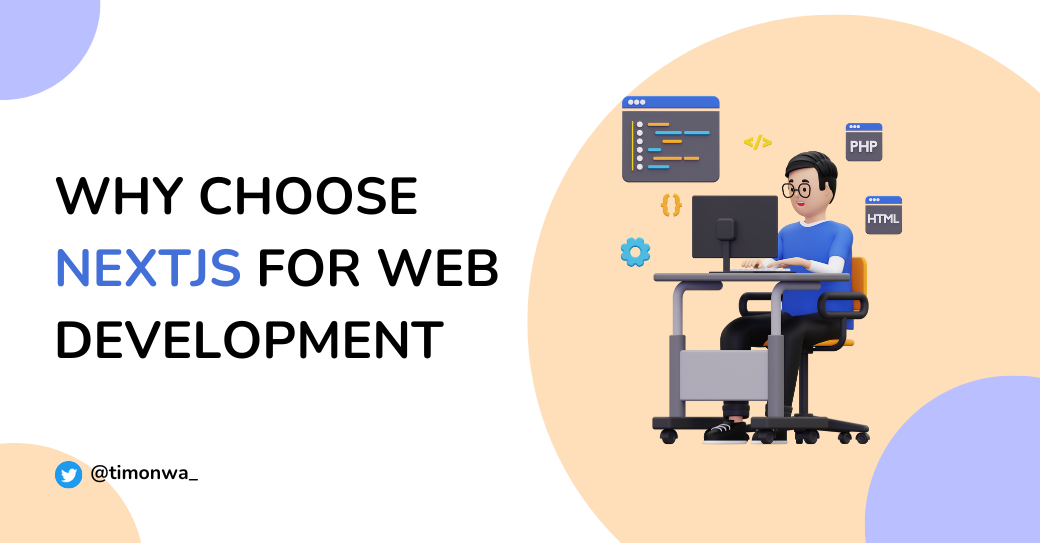Why Choose Next.js for Your Next Web Development Project in 2024
Posted on: Jun 22, 2023
6 mins read

Next.js provides developers with a straightforward solution to create high-performance, efficient, and scalable React apps. This article will explore the key features of Next.js and weigh the pros and cons of switching from React to Next.js for your next project.
Introduction to Next.js
Next.js is a robust JavaScript framework for developing server-side rendered (SSR) React applications. This framework is maintained and developed by Vercel and offers developers a simple solution to create fast, efficient, and scalable React applications. With its automatic code splitting, optimized performance, and support for CSS-in-JS libraries like styled-components, Next.js stands out as a popular choice for modern web development. Furthermore, it integrates well with popular front-end tools such as Redux, TypeScript, and GraphQL. It offers a serverless deployment option, allowing developers to focus solely on delivering exceptional user experiences.
Key Features of Next.js
The following are some of the key features that make Next.js an ideal choice for web development:
1. Server-side Rendering (SSR): Next.js provides built-in support for server-side rendering (SSR), enabling the initial render of the application to be performed on the server instead of the client. This results in faster load times and improved SEO, as search engines can easily crawl and index the rendered HTML.
2. Pre-rendering: In addition to SSR, Next.js also offers pre-rendering, which enables you to pre-render specific pages or routes to static HTML files. This leads to even faster initial load times and reduces the amount of server-side rendering required.
3. Hot Module Replacement (HMR): Another advantage of Next.js is its support for hot module replacement (HMR), allowing for live code updates without needing a full page refresh. This enhances the development experience and enables faster iteration during the development process.
4. Automatic Code Splitting: Next.js offers automatic code splitting, which automatically divides the application code into smaller chunks based on usage. This improves performance by only loading the code the user needs instead of loading the entire codebase on every page load.
4. Built-in Image Component and Automatic Image Optimization: Next.js also has a built-in Image component and automatic image optimization, providing a quick and easy way to improve application loading times and performance.
6. Community Support: Next.js has a strong community of developers with plenty of resources and tools available to help you get started and troubleshoot any issues.
7. CSS Modules: Next.js supports CSS modules, allowing you to write modular and reusable CSS scoped to a specific component. This enhances the maintainability and organization of your application's styles.
8. TypeScript Support: Next.js also supports TypeScript, enabling you to use the popular typed language in your application, resulting in improved code reliability and fewer runtime errors.
9. Zero-Config Approach: Next.js takes a zero-config approach, meaning you can start with minimal setup and configuration, saving you time and effort and enabling you to focus on building your application.
10. API Routes: Next.js offers API routes support, making it easy to create and manage your application's API endpoints. This enhances the organization and maintainability of your application's backend.
11. Routing: Next.js provides a powerful and intuitive routing system, allowing you to create and manage your application's routes and pages easily.
12. 100% React Support: Next.js offers full React support, allowing you to use all of React's features and components in your Next.js application.
13. Best SEO Practices: Finally, Next.js follows best SEO practices, ensuring that your application is optimized for search engines, improving your application's visibility, and attracting more users.
Are Next.js and React the same thing?
No, Next.js and React are not the same things. Next.js is a JavaScript framework built on top of React that makes it easier to build server-side rendered (SSR) React applications.
React, on the other hand, is a JavaScript library for building user interfaces. It allows developers to build reusable UI components and manage the state of their applications. React can be used with or without a framework, and Next.js is one of the popular frameworks used for building React applications.
So, while Next.js is built using React, it offers additional features and abstractions that make it easier to build server-side rendered applications.
Should You Switch to Next.js from React?
If you're considering switching from React to Next.js or are wondering if Next.js is the right choice for your project, here are some pros and cons to consider:
Pros of Using Next.js
Improved performance: Next.js has several performance optimizations built into the framework, such as automatic code splitting and optimized asset loading, which can help improve the overall performance of your application.
Ease of use: Next.js provides a direct development experience with a minimal setup process and a familiar file structure. This can make it easier for developers to start a new project and maintain their code over time.
Increase in conversion rate and sales: Next.js provides fast loading times and improved SEO, which can increase your business's conversion rate and sales.
Boost of marketing channels: Next.js offers a rich set of features and tools that can be used to boost marketing channels, such as social media and email marketing.
Overtake of competition: With its fast performance and advanced features, Next.js can help you overtake your competition and stay ahead in the market.
Better user experience: Next.js provides a great user experience with its fast and responsive applications, making it an excellent choice for businesses looking to improve the user experience for their customers.
Lower maintenance costs: Next.js is designed for simplicity and ease of use, making it easier to maintain and update your application, potentially leading to lower maintenance costs.
Easier business scaling: Next.js is designed for scalability, making it easier for businesses to scale their applications as their needs grow.
Robust documentation: Next.js has comprehensive documentation and tutorials, making it easy for developers to learn and use the framework.
Cons of using NextJs
Learning curve: While Next.js is designed to be simple and straightforward, it still requires a certain level of understanding and experience with React, JavaScript, and web development in general. This means there may be a learning curve for developers who are new to these technologies.
Dependence on external packages: Next.js relies on many external packages, such as React and Webpack, which can increase the risk of compatibility and security issues.
Performance overhead: Next.js provides many performance optimizations, but these optimizations can also add some performance overhead, particularly for smaller projects.
Infrastructure: If you are using the serverless option for deploying your Next.js application, consider the additional infrastructure and costs associated with this.
Limited customization options: Next.js has a set of conventions and best practices that developers should follow, which can limit customization options for some projects.
Conclusion
In conclusion, Next.js is a powerful and popular framework for building fast and efficient React applications. It offers a wide range of features and advantages, such as automatic code splitting, optimized performance, simple client-side navigation, built-in support for CSS-in-JS libraries, integration with popular front-end tools, and a serverless option for deployment.
While there may be a learning curve and additional dependencies, Next.js provides a simple, efficient, and scalable solution for building great user experiences, helping businesses achieve their goals, and improving their online presence. With its strong community of developers and support, its focus on performance, ease of use, and best SEO practices, Next.js is worth considering for your next web development project.
It's also important to keep in mind that switching from React to Next.js may require some investment in terms of time and effort, especially if you're already familiar with React and have a large codebase built with it. It may be worth considering if you're looking to take your web development to the next level, but consider the costs and benefits before deciding.
Thank you for reading my article. Please share it with your friends. Till next time, Adios!

Image from
giphy.com
Resources
Connect With Me
Follow me on X(Twitter), and LinkedIn to stay updated with my latest content.
If you like my notes and want to support me, you can sponsor me on GitHub Sponsor, or you can buy me a virtual ice cream on ByMeACoffee or Selar. I would really appreciate it. 🙏
For other ways to support me, visit my Sponsorship page or Affiliate Links page.
